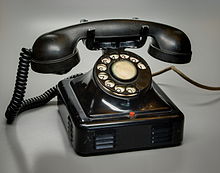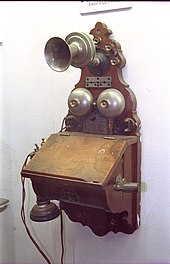
A telephone is a telecommunications device that permits two or more users to conduct a conversation when they are too far apart to be easily heard directly. A telephone converts sound, typically and most efficiently the human voice, into electronic signals that are transmitted via cables and other communication channels to another telephone which reproduces the sound to the receiving user. The term is derived from Greek: τῆλε (tēle, far) and φωνή (phōnē, voice), together meaning distant voice. A common short form of the term is phone, which came into use early in the telephone’s history.[1]
In 1876, Alexander Graham Bell was the first to be granted a United States patent for a device that produced clearly intelligible replication of the human voice at a second device.[2] This instrument was further developed by many others, and became rapidly indispensable in business, government, and in households.
The essential elements of a telephone are a microphone (transmitter) to speak into and an earphone (receiver) which reproduces the voice at a distant location.[3] The receiver and transmitter are usually built into a handset which is held up to the ear and mouth during conversation. The transmitter converts the sound waves to electrical signals which are sent through the telecommunication system to the receiving telephone, which converts the signals into audible sound in the receiver or sometimes a loudspeaker. Telephones permit transmission in both directions simultaneously.
Most telephones also contain an alerting feature, such as a ringer or a visual indicator, to announce an incoming telephone call. Telephone calls are initiated most commonly with a keypad or dial, affixed to the telephone, to enter a telephone number, which is the address of the call recipient’s telephone in the telecommunication system, but other methods existed in the early history of the telephone.
The first telephones were directly connected to each other from one customer’s office or residence to another customer’s location. Being impractical beyond just a few customers, these systems were quickly replaced by manually operated centrally located switchboards. These exchanges were soon connected together, eventually forming an automated, worldwide public switched telephone network. For greater mobility, various radio systems were developed for transmission between mobile stations on ships and automobiles in the mid-20th century. Hand-held mobile phones were introduced for personal service starting in 1973. In later decades, their analog cellular system evolved into digital networks with greater capability and lower cost.
Convergence in communication services has provided a broad spectrum of capabilities in cell phones, including mobile computing, giving rise to the smartphone, the dominant type of telephone in the world today.
Early history
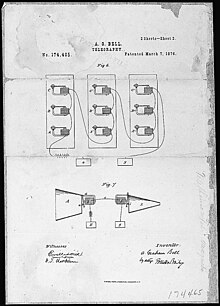
Alexander Graham Bell’s Telephone Patent Drawing
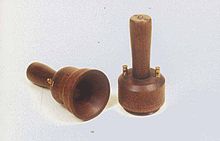
Replica of the telettrofono, invented by Antonio Meucci and credited by several sources as the first telephone[4]
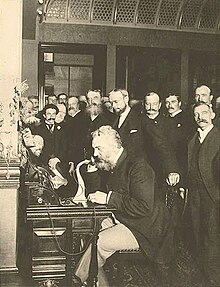
Bell placing the first New York to Chicago telephone call in 1892
Before the development of the electric telephone, the term telephone was applied to other inventions, and not all early researchers of the electrical device used the term. Perhaps the earliest use of the word for a communications system was the telephon created by Gottfried Huth in 1796. Huth proposed an alternative to the optical telegraph of Claude Chappe in which the operators in the signaling towers would shout to each other by means of what he called «speaking tubes», but would now be called giant megaphones.[5] A communication device for sailing vessels, called telephone, was invented by Captain John Taylor in 1844. This instrument used four air horns to communicate with vessels in foggy weather.[6][7]
Johann Philipp Reis used the term in reference to his invention, commonly known as the Reis telephone, in c. 1860. His device appears to be the first device based on the conversion of sound into electrical impulses.
The term telephone was adopted into the vocabulary of many languages. It is derived from the Greek: τῆλε, tēle, «far» and φωνή, phōnē, «voice», together meaning «distant voice».
Credit for the invention of the electric telephone is frequently disputed. As with other influential inventions such as radio, television, the light bulb, and the computer, several inventors pioneered experimental work on voice transmission over a wire and improved on each other’s ideas. New controversies over the issue still arise from time to time. Charles Bourseul, Antonio Meucci, Johann Philipp Reis, Alexander Graham Bell, and Elisha Gray, amongst others, have all been credited with the invention of the telephone.[8][9]
Alexander Graham Bell was the first to be awarded a patent for the electric telephone by the United States Patent and Trademark Office (USPTO) in March 1876.[10] Before Bell’s patent, the telephone transmitted sound in a way that was similar to the telegraph. This method used vibrations and circuits to send electrical pulses, but was missing key features. Bell found that this method produced a sound through intermittent currents, but in order for the telephone to work a fluctuating current reproduced sounds the best. The fluctuating currents became the basis for the working telephone, creating Bell’s patent.[11] That first patent by Bell was the master patent of the telephone, from which other patents for electric telephone devices and features flowed.[12]
In 1876, shortly after Bell’s patent application, Hungarian engineer Tivadar Puskás proposed the telephone switch, which allowed for the formation of telephone exchanges, and eventually networks.[13]
In the United Kingdom, the blower is used as a slang term for a telephone. The term came from navy slang for a speaking tube.[14] In the U.S., a somewhat dated slang term refers to the telephone as «the horn,» as in «I couldn’t get him on the horn,» or «I’ll be off the horn in a moment.»[15]
Timeline of early development
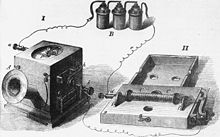
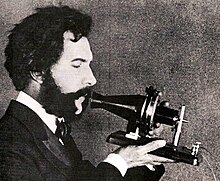
Bell’s first telephone transmitter, ca. 1876, reenacted 50 years later
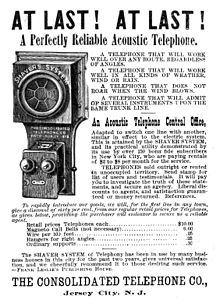
Acoustic telephone ad, The Consolidated Telephone Co., Jersey City, New Jersey, 1886

1896 telephone from Sweden
Wooden wall telephone with a hand-cranked magneto generator
- 1844: Innocenzo Manzetti first mooted the idea of a «speaking telegraph» or telephone. Use of the «speaking telegraph» and «sound telegraph» monikers would eventually be replaced by the newer, distinct name, «telephone».
- 26 August 1854: Charles Bourseul published an article in the magazine L’Illustration (Paris): «Transmission électrique de la parole» (electric transmission of speech), describing a «make-and-break» type telephone transmitter later created by Johann Reis.
- 26 October 1861: Johann Philipp Reis (1834–1874) publicly demonstrated the Reis telephone before the Physical Society of Frankfurt.[9] Reis’s telephone was not limited to musical sounds. Reis also used his telephone to transmit the phrase «Das Pferd frisst keinen Gurkensalat» («The horse does not eat cucumber salad»).
- 22 August 1865, La Feuille d’Aoste reported «It is rumored that English technicians to whom Manzetti illustrated his method for transmitting spoken words on the telegraph wire intend to apply said invention in England on several private telegraph lines».[citation needed] However, telephones would not be demonstrated there until 1876, with a set of telephones from Bell.
- 28 December 1871: Antonio Meucci files patent caveat No. 3335 in the U.S. Patent Office, titled «Sound Telegraph», describing communication of voice between two people by wire. A patent caveat was not an invention patent award, but only an unverified notice filed by an individual that he or she intends to file a patent application in the future.
- 1874: Meucci, after having renewed the caveat for two years does not renew it again, and the caveat lapses.
- 6 April 1875: Bell’s U.S. Patent 161,739 «Transmitters and Receivers for Electric Telegraphs» is granted. This uses multiple vibrating steel reeds in make-break circuits.
- 11 February 1876: Elisha Gray invents a liquid transmitter for use with the telephone but does not build one.
- 14 February 1876: Gray files a patent caveat for transmitting the human voice through a telegraphic circuit.
- 14 February 1876: Alexander Graham Bell applies for the patent «Improvements in Telegraphy», for electromagnetic telephones using what is now called amplitude modulation (oscillating current and voltage) but which he referred to as «undulating current».
- 19 February 1876: Gray is notified by the U.S. Patent Office of an interference between his caveat and Bell’s patent application. Gray decides to abandon his caveat.
- 7 March 1876: Bell’s U.S. patent 174,465 «Improvement in Telegraphy» is granted, covering «the method of, and apparatus for, transmitting vocal or other sounds telegraphically…by causing electrical undulations, similar in form to the vibrations of the air accompanying the said vocal or other sound.»
- 10 March 1876: The first successful telephone transmission of clear speech using a liquid transmitter when Bell spoke into his device, «Mr. Watson, come here, I want to see you.» and Watson heard each word distinctly.
- 30 January 1877: Bell’s U.S. patent 186,787 is granted for an electromagnetic telephone using permanent magnets, iron diaphragms, and a call bell.
- 27 April 1877: Thomas Edison files a patent application for a carbon (graphite) transmitter. It was published as No. 474,230 on 3 May 1892, after a 15-year delay because of litigation. Edison was granted patent 222,390 for a carbon granules transmitter in 1879.
Early commercial instruments
Early telephones were technically diverse. Some used a water microphone, some had a metal diaphragm that induced current in an electromagnet wound around a permanent magnet, and some were dynamic – their diaphragm vibrated a coil of wire in the field of a permanent magnet or the coil vibrated the diaphragm. The sound-powered dynamic variants survived in small numbers through the 20th century in military and maritime applications, where its ability to create its own electrical power was crucial. Most, however, used the Edison/Berliner carbon transmitter, which was much louder than the other kinds, even though it required an induction coil which was an impedance matching transformer to make it compatible with the impedance of the line. The Edison patents kept the Bell monopoly viable into the 20th century, by which time the network was more important than the instrument.
Early telephones were locally powered, using either a dynamic transmitter or by the powering of a transmitter with a local battery. One of the jobs of outside plant personnel was to visit each telephone periodically to inspect the battery. During the 20th century, telephones powered from the telephone exchange over the same wires that carried the voice signals became common.
Early telephones used a single wire for the subscriber’s line, with ground return used to complete the circuit (as used in telegraphs). The earliest dynamic telephones also had only one port opening for sound, with the user alternately listening and speaking (or rather, shouting) into the same hole. Sometimes the instruments were operated in pairs at each end, making conversation more convenient but also more expensive.
At first, the benefits of a telephone exchange were not exploited. Instead, telephones were leased in pairs to a subscriber, who had to arrange for a telegraph contractor to construct a line between them, for example, between a home and a shop. Users who wanted the ability to speak to several different locations would need to obtain and set up three or four pairs of telephones. Western Union, already using telegraph exchanges, quickly extended the principle to its telephones in New York City and San Francisco, and Bell was not slow in appreciating the potential.
Signalling began in an appropriately primitive manner. The user alerted the other end, or the exchange operator, by whistling into the transmitter. Exchange operation soon resulted in telephones being equipped with a bell in a ringer box, first operated over a second wire, and later over the same wire, but with a condenser (capacitor) in series with the bell coil to allow the AC ringer signal through while still blocking DC (keeping the phone «on hook»). Telephones connected to the earliest Strowger switch automatic exchanges had seven wires, one for the knife switch, one for each telegraph key, one for the bell, one for the push-button and two for speaking. Large wall telephones in the early 20th century usually incorporated the bell, and separate bell boxes for desk phones dwindled away in the middle of the century.
Rural and other telephones that were not on a common battery exchange had a magneto hand-cranked generator to produce a high voltage alternating signal to ring the bells of other telephones on the line and to alert the operator. Some local farming communities that were not connected to the main networks set up barbed wire telephone lines that exploited the existing system of field fences to transmit the signal.
In the 1890s a new smaller style of telephone was introduced, packaged in three parts. The transmitter stood on a stand, known as a «candlestick» for its shape. When not in use, the receiver hung on a hook with a switch in it, known as a «switchhook». Previous telephones required the user to operate a separate switch to connect either the voice or the bell. With the new kind, the user was less likely to leave the phone «off the hook». In phones connected to magneto exchanges, the bell, induction coil, battery and magneto were in a separate bell box or «ringer box».[16] In phones connected to common battery exchanges, the ringer box was installed under a desk, or other out-of-the-way place, since it did not need a battery or magneto.
Cradle designs were also used at this time, having a handle with the receiver and transmitter attached, now called a handset, separate from the cradle base that housed the magneto crank and other parts. They were larger than the «candlestick» and more popular.
Disadvantages of single-wire operation such as crosstalk and hum from nearby AC power wires had already led to the use of twisted pairs and, for long-distance telephones, four-wire circuits. Users at the beginning of the 20th century did not place long-distance calls from their own telephones but made an appointment and were connected with the assistance of a telephone operator.[17]
What turned out to be the most popular and longest-lasting physical style of telephone was introduced in the early 20th century, including Bell’s 202-type desk set. A carbon granule transmitter and electromagnetic receiver were united in a single molded plastic handle, which when not in use was secured in a cradle in the base unit. The circuit diagram of the model 202 shows the direct connection of the transmitter to the line, while the receiver was inductively coupled. In local battery configurations, when the local loop was too long to provide sufficient current from the exchange, the transmitter was powered by a local battery and inductively coupled, while the receiver was included in the local loop.[18] The coupling transformer and the ringer were mounted in a separate enclosure, called the subscriber set. The dial switch in the base interrupted the line current by repeatedly but very briefly disconnecting the line one to ten times for each digit, and the hook switch (in the center of the circuit diagram) disconnected the line and the transmitter battery while the handset was on the cradle.
In the 1930s, telephone sets were developed that combined the bell and induction coil with the desk set, obviating a separate ringer box. The rotary dial becoming commonplace in the 1930s in many areas enabled customer-dialed service, but some magneto systems remained even into the 1960s. After World War II, the telephone networks saw rapid expansion and more efficient telephone sets, such as the model 500 telephone in the United States, were developed that permitted larger local networks centered around central offices. A breakthrough new technology was the introduction of Touch-Tone signaling using push-button telephones by American Telephone & Telegraph Company (AT&T) in 1963.[19]
-
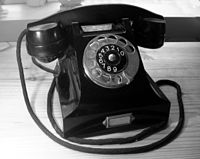
Ericsson DBH 1001 (ca. 1931), the first combined telephone made with a Bakelite housing and handset
-
Video shows the operation of an Ericofon.
-

Digital telephones and voice over IP
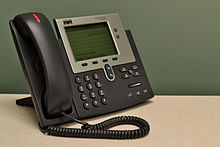
An IP desktop telephone attached to a computer network

Fixed telephone lines per 100 inhabitants 1997–2007
The invention of the transistor in 1947 dramatically changed the technology used in telephone systems and in the long-distance transmission networks, over the next several decades. With the development of stored program control and MOS integrated circuits for electronic switching systems, and new transmission technologies such as pulse-code modulation (PCM), telephony gradually evolved towards digital telephony, which improved the capacity, quality, and cost of the network.[20]
Integrated Services Digital Network (ISDN) was launched in the 1980’s, providing businesses and consumers with access to digital telephony services such as data, voice, video, and fax services. [21]
The development of digital data communications methods made it possible to digitize voice and transmit it as real-time data across computer networks and the Internet, giving rise to the field of Internet Protocol (IP) telephony, also known as voice over Internet Protocol (VoIP). VoIP has proven to be a disruptive technology that is rapidly replacing traditional telephone network infrastructure.[22]
By January 2005, up to 10% of telephone subscribers in Japan and South Korea had switched to this digital telephone service. A January 2005 Newsweek article suggested that Internet telephony may be «the next big thing.»[23] The technology has spawned a new industry comprising many VoIP companies that offer services to consumers and businesses. The reported global VoIP market in October 2021 was $85.2 billion with a projection of $102.5 billion by 2026.[24]
IP telephony uses high-bandwidth Internet connections and specialized customer premises equipment to transmit telephone calls via the Internet, or any modern private data network. The customer equipment may be an analog telephone adapter (ATA) which translates the signals of a conventional analog telephone; an IP Phone, a dedicated standalone device; or a computer softphone application, utilizing the microphone and headset devices of a personal computer or smartphone.[25]
While traditional analog telephones are typically powered from the central office through the telephone line, digital telephones require a local power supply.[26] Internet-based digital service also requires special provisions to provide the service location to the emergency services when an emergency telephone number is called.[27]
Cordless telephones

A cordless telephone system consisting of a handset resting on a base station (left) and a second handset resting on a battery charger unit (right)
A cordless telephone or portable telephone consists of a base station unit and one or more portable cordless handsets. The base station connects to a telephone line, or provides service by voice over IP (VOIP). The handset communicates with the base station via radio frequency signals. A handset’s operational range is limited, usually to within the same building or within a short distance from the base station.
Base station
Base stations include a radio transceiver which enables full-duplex, outgoing and incoming signals and speech with the handsets. The base station often includes a microphone, audio amplifier, and a loudspeaker to enable hands-free speakerphone conversations, without needing to use a handset. The base station may also have a numeric keypad for dialing, and a display for caller ID. In addition, answering machine function may be built in.[28]
The cordless handset contains a rechargeable battery, which the base station recharges when the handset rests in its cradle. Muilt-handset systems generally also have additional charging stands. A cordless telephone typically requires a constant electricity supply to power the base station and charger units by means of a DC transformer which plugs into a wall AC power outlet.[28]
Mobile phones

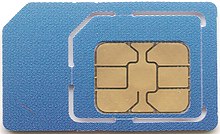
A typical SIM card (mini-SIM with a cutout to convert the card to micro-SIM size)

A mobile phone or cellphone or hand phone is a handheld telephone which connects via radio transmissions to a cellular telephone network. The cellular network consists of a network of ground based transmitter/receiver stations with antennas – which are usually located on towers or on buildings – and infrastructure connecting to land-based telephone lines.[29] Analog cellular networks first appeared in 1979, with the first digital cellular networks appearing in the early 1990s.[30]
Mobile phones require a SIM card to be inserted into the phone. The SIM card is a small PVC card containing a small integrated circuit which stores the user’s international mobile subscriber identity (IMSI) number and its related key, which are used to identify and authenticate subscribers to the cellular network.
Mobile phones generally incorporate an LCD or OLED display, with some types, such as smartphones, having touch screens. Since the 1990s, mobile phones have gained other features which are not directly related to their primary function as telephones. These include text messaging, calendars, alarm clocks, personal schedulers, cameras, music players, games and later, internet access and smartphone functionality. Nearly all mobile phones have the ability to send text messages to other users via the SMS (Short Message Service) protocol. The multimedia messaging service (MMS) protocol enables users to send and receive multimedia content, such as photos, audio files and video files. As their functionality has increased over the years, many types of mobile phone, notably smartphones, require an operating system to run. Popular mobile phone operating systems in the past have included Symbian, Palm OS, BlackBerry OS and mobile phone versions of Windows. As of 2022, the most used operating systems are Google’s Android and Apple’s iOS.[31]
Before the era of smartphones, mobile phones were generally manufactured by companies specializing in telecommunications equipment, such as Nokia, Motorola, and Ericsson. Since the advent of smartphones, mobile phone manufacturers have also included consumer electronics companies, such as Apple, Samsung and Xiaomi.
Smartphones

As of 2022, most mobile phones are smartphones, being a combination of a mobile phone and a personal computing device in the same unit. Most smartphones are primarily operated using a graphical user interface and a touch screen. Many phones have a secondary voice user interface, such as Siri on Apple iPhones, which can operate many of the device’s functions, as well as enabling users to use spoken commands to interact with the internet. Typically alphanumeric text input is accomplished via an on-screen virtual keyboard, although some smartphones have a small physical keyboard. Smartphones offer the ability to access internet data through the cellular network and via wi-fi, and usually allow direct connectivity to other devices via Bluetooth or a wired interface, such as USB or Lightning connectors. Smartphones, being able to run apps, have vastly expanded functionality compared to previous mobile phones. Having internet access and built in cameras, smartphones have made video calling readily accessible via IP connections. Smartphones also have access to a large number of web services and web apps, giving them functionality similar to traditional computers, although smartphones are often limited by their relatively small screen size and the size of their keyboards. Typically, smartphones feature such tools as cameras, media players, web browsers, email clients, interactive maps, satellite navigation and a variety of sensors, such as a compass, accelerometers and GPS receivers. In addition to voice calls, smartphone users commonly communicate using a wide variety of messaging formats, including SMS, MMS, email, and various proprietary messaging services, such as iMessage and various social media platforms.
Mobile phone usage
In 2002, only 10% of the world’s population used mobile phones and by 2005 that percentage had risen to 46%.[32] By the end of 2009, there were a total of nearly 6 billion mobile and fixed-line telephone subscribers worldwide. This included 1.26 billion fixed-line subscribers and 4.6 billion mobile subscribers.[33]
Satellite phones
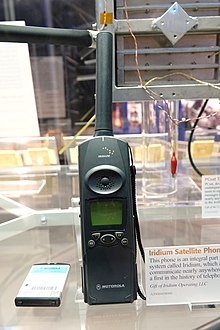
First generation late 1990s Iridium satellite phone
A satellite telephone is a type of mobile phone that connects to other phones or the telephone network by radio link through satellites orbiting the Earth instead of terrestrial cell sites, as cellphones do. Therefore, they can work in most geographic locations on the Earth’s surface, as long as open sky and the line-of-sight between the phone and the satellite is provided. Depending on the architecture of a particular system, coverage may include the entire Earth or only specific regions. Satellite phones provide similar functionality to terrestrial mobile telephones; voice calling, text messaging, and low-bandwidth Internet access are supported through most systems. The advantage of a satphone is that it can be used in such regions where local terrestrial communication infrastructures, such as landline and cellular networks, are not available.
Satphones are popular on expeditions into remote locations, hunting, fishing, maritime sector, humanitarian missions, bussines trips, and mining in hard-to-reach areas, where there is no reliable cellular service.[34] Satellite telephones rarely get disrupted by natural disasters on Earth or human actions such as war, so they have proven to be dependable communication tools in emergency situations, when the local communications system can be compromised.[35]
See also
- Bell System
- Bell Telephone Memorial
- Cellular network
- Cordless telephone
- Harvard sentences
- Index of telephone-related articles
- Jipp curve
- List of telephone operating companies
- Mobile operating system
- Multimedia messaging service (MMS)
- Party line (telephony)
- Phone hacking
- Radiotelephone
- Satellite phone
- SIM card
- Spamming
- Telephone keypad
- Telephone jack and plug
- Telephone tapping
- Tip and ring
- Videophone
References
- ^ «Etymology of the word «phone»«.
- ^ «Who Is Credited With Inventing the Telephone». Library of Congress.
- ^ «United States Coast Guard Sound-Powered Telephone Talkers Manual, 1979, p. 1″ (PDF). Archived from the original (PDF) on 2018-05-14. Retrieved 2018-05-13.
- ^ Carroll, Rory (June 17, 2002). «Bell did not invent telephone, US rules» – via www.theguardian.com.
- ^ Holzmann, Gerard J.; Pehrson, Björn, The Early History of Data Networks, pp. 90–91, Wiley, 1995 ISBN 0818667826.
- ^ The Year-book of Facts in Science and Art. Simpkin, Marshall, and Company. July 6, 1845. p. 55 – via Internet Archive.
- ^ «The Telephone and Telephone Exchanges» by J. E. Kingsbury published in 1915.
- ^ Coe, Lewis (1995). The Telephone and Its Several Inventors: A History. Jefferson, NC: McFarland & Company, Inc. p. 5. ISBN 978-0-7864-2609-6.
- ^ a b Kempe, Harry Robert; Garcke, Emile (1911). «Telephone» . In Chisholm, Hugh (ed.). Encyclopædia Britannica. Vol. 26 (11th ed.). Cambridge University Press. pp. 547–57.
- ^ Brown, Travis (1994). Historical first patents: the first United States patent for many everyday things (illustrated ed.). University of Michigan: Scarecrow Press. p. 179. ISBN 978-0-8108-2898-8.
- ^ Beauchamp, Christopher (2010). «Who Invented the Telephone?: Lawyers, Patents, and the Judgments of History». Technology and Culture. 39: 858–859 – via Project MUSE.
- ^ US 174465 Alexander Graham Bell: «Improvement in Telegraphy» filed on February 14, 1876, granted on March 7, 1876.
- ^ «Puskás, Tivadar». Omikk.bme.hu. Retrieved 2010-05-23.
- ^ Rick Jolly (2018). Jackspeak: A guide to British Naval slang & usage. p. 46. ISBN 9781472834140.
- ^ «on the horn». Merriam-Webster. Retrieved 25 August 2021.
{{cite encyclopedia}}: CS1 maint: url-status (link) - ^ «Ringer Boxes». Telephonymuseum.com. Archived from the original on 2001-10-12. Retrieved 2010-05-23.
- ^ DiPirro, Peggy. «The beginning of long distance telephone service». The Palm Beach Post. Retrieved 2022-08-25.
- ^ Circuit Diagram, Model 102, Porticus Telephone website.
- ^ «Tone dialing telephones are introduced, November 18, 1963». EDN.
{{cite web}}: CS1 maint: url-status (link) - ^ Allstot, David J. (2016). «Switched Capacitor Filters». In Maloberti, Franco; Davies, Anthony C. (eds.). A Short History of Circuits and Systems: From Green, Mobile, Pervasive Networking to Big Data Computing (PDF). IEEE Circuits and Systems Society. pp. 105–110. ISBN 9788793609860. Archived from the original (PDF) on 2021-09-30. Retrieved 2019-11-29.
- ^ «What is ISDN – Essentials Guide » Electronics Notes». www.electronics-notes.com. Retrieved 2022-08-28.
- ^ «VoIP is winning over a variety of phone users». Orlando Sentinel. Retrieved 2022-08-25.
- ^ Sheridan, Barrett. «Newsweek – National News, World News, Health, Technology, Entertainment and more…» MSNBC. Archived from the original on January 18, 2005. Retrieved 2010-05-23.
- ^ «Global VoIP Services Market 2021–2026». Research and Markets. October 2021.
- ^ «VoIP Equipment Guide 2022: Types of Hardware + Top Manufacturers». getvoip.com. Retrieved 2022-08-25.
- ^ «VoIP Phone System Battery Backups | voipreview.org». VoipReview. 2011-09-15. Retrieved 2022-08-25.
- ^ «VoIP and 911 Service». Federal Communications Commission. 2011-05-26. Retrieved 2022-08-25.
- ^ a b Freudenrich, Craig (2000-12-11). «How Cordless Telephones Work». HowStuffWorks. InfoSpace Holdings. Retrieved 2022-08-07.
- ^ Walters, Lourens O; Kritzinger, PS (December 2000). «Cellular Networks: Past, Present, and Future». XRDS: Crossroads, the ACM Magazine for Students. Association for Computing Machinery. 7 (2): 4–ff35. doi:10.1145/355146.355149. S2CID 16237742. Archived from the original on 2022-11-05. Retrieved 2022-10-31.
- ^ Galazzo, Richard (2022-01-24). «From 1G to 5G: The History of Cell Phones and their Cellular Generations». CENGN. CENGN. Archived from the original on 2022-10-05. Retrieved 2022-10-07.
- ^ «Smartphones Market – Growth, Trends, COVID-19 Impact, and Forecasts (2022–2027)». Mordor Intelligence. Mordor Intelligence. 2022. Archived from the original on 8 August 2022. Retrieved 8 August 2022.
- ^ «Are Cell Phones Ruining Our Social Skills? – SiOWfa15: Science in Our World: Certainty and Controversy». sites.psu.edu.
- ^ Next-Generation Networks Set to Transform Communications, Archived 2016-03-03 at the Wayback Machine International Telecommunication Union website, 4 September 2007. Retrieved 5 July 2009.
- ^ ruge.axessnet (2018-08-28). «Satellite phone: know the 5 sectors that use them the most». axessnet. Retrieved 2023-01-13.
- ^ «Everything That You Need to Know About a Satellite Phone». Satellite Phone Review. Retrieved 2023-01-12.
Further reading
- Brooks, John (1976). Telephone: The first hundred years. HarperCollins.
- Bruce, Robert V. (1990). Bell: Alexander Graham Bell and the Conquest of Solitude. Cornell University Press. ISBN 978-0-8014-9691-2.
- Casson, Herbert Newton. (1910) The history of the telephone online.
- Coe, Lewis (1995). The Telephone and Its Several Inventors: A History. Jefferson, NC: McFarland & Co.
- Evenson, A. Edward (2000). The Telephone Patent Conspiracy of 1876: The Elisha Gray – Alexander Bell Controversy. Jefferson, NC: McFarland & Co.
- Fischer, Claude S. (1994) America calling: A social history of the telephone to 1940 (Univ of California Press, 1994)
- Huurdeman, Anton A. (2003). The Worldwide History of Telecommunications Hoboken: NJ: Wiley-IEEE Press.
- John, Richard R. (2010). Network Nation: Inventing American Telecommunications. Cambridge, MA: Harvard University Press.
- MacDougall, Robert. The People’s Network: The Political Economy of the Telephone in the Gilded Age. Philadelphia: University of Pennsylvania Press.
- Mueller, Milton. (1993) «Universal service in telephone history: A reconstruction.» Telecommunications Policy 17.5 (1993): 352–69.
- Todd, Kenneth P. (1998), A Capsule History of the Bell System. American Telephone & Telegraph Company (AT&T).
External links
![]()
Wikimedia Commons has media related to Telephone.
- Early U.S. Telephone Industry Data
- «Telephone» . New International Encyclopedia. 1905.
- Kempe, Harry Robert; Garcke, Emile (1911). «Telephone» . Encyclopædia Britannica. Vol. 26 (11th ed.). pp. 547–557.
- Virtual museum of early telephones
- The Telephone, 1877
- The short film «Now You’re Talking (1927)» is available for free download at the Internet Archive.
- The short film «Communication (1928)» is available for free download at the Internet Archive.
- The short film «Telephone Memories (Reel 1 of 2) (1931)» is available for free download at the Internet Archive.
- The short film «Telephone Memories (Reel 2 of 2) (1931)» is available for free download at the Internet Archive.
- The short film «Far Speaking (ca. 1935)» is available for free download at the Internet Archive.
- «US 174,465». pdfpiw.uspto.gov.—Telegraphy (Bell’s first telephone patent)—Alexander Graham Bell
- US 186,787—Electric Telegraphy (permanent magnet receiver)—Alexander Graham Bell
- US 474,230—Speaking Telegraph (graphite transmitter)—Thomas Edison
- US 203,016—Speaking Telephone (carbon button transmitter)—Thomas Edison
- US 222,390—Carbon Telephone (carbon granules transmitter)—Thomas Edison
- US 485,311—Telephone (solid back carbon transmitter)—Anthony C. White (Bell engineer) This design was used until 1925 and installed phones were used until the 1940s.
- US 3,449,750—Duplex Radio Communication and Signalling Apparatus—G. H. Sweigert
- US 3,663,762—Cellular Mobile Communication System—Amos Edward Joel (Bell Labs)
- US 3,906,166—Radio Telephone System (DynaTAC cell phone)—Martin Cooper et al. (Motorola)
Представлено сочинение на английском языке Изобретение телефона/ Telephone Invention с переводом на русский язык.
| Telephone Invention | Изобретение телефона |
| Just like a radio invention, lots of inventors and scientists took part in a telephone invention. Right now the official telephone inventor is Antonio Meucci, an Italian scientist, who was the first one to publish telephone device in 1860. | В изобретении телефона, как, например и радио, поучаствовало огромное количество изобретателей и учёных. В данный момент, официальным изобретателем телефона является Антонио Меуччи, итальянский учёный, который первым опубликовал устройство телефона в 1860 году. |
| In 1861, another scientist Johann Philipp Reis demonstrated a device that looked like a phone. | В 1861 году другой учёный Иоганн Филипп Рейс продемонстрировал устройство похожее на телефон. |
| The most famous inventor is Alexander Bell who was considered the main inventor but in 2012 it was officially announced to be Meucci. It happened because Bell was the first one to file a patent for his phone in 1876 and Meucci didn’t know English and was too poor to do it before Bell. It is interesting that another scientist Elisha Gray tried to file a patent for his phone on the same day. | Самым известным изобретателем телефона является Александр Белл, которого многие годы считали главным изобретателем, пока в 2012 году первенство не перешло к Меуччи. Это произошло из-за того, что Белл первым запатентовал телефон в 1876 году, а Меуччи, из-за плохого знания английского языка и бедности, не смог этого сделать ранее. Самое интересное, что в этот же день, ещё один учёный, Элиша Грей, пытался запатентовать телефон. |
| After a telephone was invented it was constantly improved. The ring was made as well as a button microphone, rotary and push-button dial, a speaker and so on. | После изобретения телефона он постоянно улучшался и усовершенствовался. Появился звонок, угольный микрофон, дисковый и кнопочный наборы, громкая связь и многое другое. |
| In 1973, a cell phone was invented. The first phone call was made by the inventor Martin Cooper who derisively call his competitor Joel Engel from AT&T on April 3, 1973. Martin was working in Motorola back then. The first cell phone weighted over 1 kg and was very big plus you had to charge it for more than 10 hours. | А в 1973 году был изобретён сотовый телефон. Первый звонок по этому телефону был сделан его изобретателем Мартином Купером, когда он 3 апреля 1973 года, в насмешку, позвонил конкуренту из AT&T, Джоэлю Энгелю. Сам же он работал в Motorola. Первый телефон весил более килограмма и имел внушительные размеры, а заряжать его нужно было более 10 часов. |
| Ten years later cell phones became popular among people and they started to buy it in wholesale numbers. Despite the fact that it was developing so fast it took years for a cell phone to conquer the world. For example, the first cell phones finally came to the USSR in 1991 and the first owners were very rich people. If someone had a cell phone it meant that it was a very important person. | Прошло около 10 лет, чтобы сотовый телефон стал популярным у населения и его начали массово покупать. Несмотря на быстрое развитие, сотовой связи понадобилось ещё много лет, чтобы завоевать мир. Например, в СССР он появился только в 1991 году, и первые его обладатели были, в основном, очень богатые люди. Наличие мобильного телефона говорило о высоком статусе владельца. |
| At the moment everyone can buy a cell phone and nowadays it is not just a phone but a small computer that has hundreds of functions and the Internet access. | В данный момент абсолютно любой человек может позволить себе сотовый телефон, который уже стал не просто телефоном, а миникомпьютером с сотнями функций и выходом в интернет. |
| На английском языке | Перевод на русский язык |
| Telephone | Телефон |
| People have invented many useful devices. One of the most interesting and widely-used inventions is the telephone. The modern phone that we use today is the result of work of many people. The first person to have patented the telephone in 1876 was Alexander Graham Bell. He is credited as the inventor of this practical device. Other scientists who also worked on telephone invention were Elisha Gray, Antonio Meucci, Thomas Edison and some others. The 20th century was the era of phone development and modernization. Rotary telephones were replaced by touch-tone dials and other sophisticated features. Modern phones are presented mostly by mobiles, which support IP telephony and wi-fi. It is almost impossible to find a person nowadays who doesn’t have a personal mobile phone. These phones have become highly popular over the last years. They are rather compact, handy and easy to carry around. Mobile phones allow us to make instant calls, send text messages, listen to music, play games, take photos, check an e-mail and else. Thus, they have replaced not only landlines but also personal computers, MP3-players and cameras. However, there are many people in the world who are against mobiles phones. Doctors claim that this device has a bad effect on people’s health. It can damage our eyesight and immune system. The signals that are sent from mobiles can be harmful. Some people also believe that phones prevent live communication. And, it is true. With the appearance of mobile phones and computers people meet up with friends less often. In my opinion, telephone is a very useful and important device. We simply can’t live without it in the modern world, even though it is not safe for health. The only solution is to try to use it less in everyday life. | Люди изобретали много полезных устройств. Одним из наиболее интересных и широко используемых изобретений является телефон. Современный телефон, который мы используем сегодня, является результатом работы многих людей. Первым человеком, который запатентовал телефон в 1876 году, был Александр Грэхем Белл. Ему приписывают изобретение этого практичного устройства. Другие ученые, которые также работали над изобретением телефона, это Элиша Грэй, Антонио Меуччи, Томас Эдисон и некоторые другие.20-й век был эпохой развития и модернизации телефона. Телефоны с дисковым набором были заменены тональным набором и другими замысловатыми функциями. Современные телефоны представлены в основном мобильными телефонами, которые поддерживают IP-телефонию и беспроводной интернет. Почти невозможно найти человека, в настоящее время, который не имеет личного мобильного телефона. Эти телефоны стали очень популярны в последние годы. Они достаточно компактны, удобны и легко переносятся. Мобильные телефоны позволяют нам совершать мгновенные звонки, отправлять текстовые сообщения, слушать музыку, играть в игры, делать фотографии, проверять электронную почту и многое другое. Таким образом, они заменили не только стационарные телефоны, но и персональные компьютеры, MP3-плееры и фотоаппараты. Тем не менее, в мире полно людей, которые против мобильных телефонов. Врачи утверждают, что это устройство плохо влияет на здоровье людей. Оно может повредить зрение и иммунную систему. Сигналы, которые посылаются с мобильных телефонов, могут быть вредными. Некоторые люди также считают, что телефоны препятствуют живому общению. И это правда. С появлением мобильных телефонов и компьютеров люди стали встречаться с друзьями реже. На мой взгляд, телефон является очень полезным и важным устройством. Мы просто не можем жить без него в современном мире, даже если это не безопасно для здоровья. Единственный выход, это пытаться использовать его реже в повседневной жизни. |
Телефон/ Telephone
Мобильные телефоны
Mobile phones
by Craig Duncan
When Scotsman Alexander Graham Bell invented the telephone in 1876, it was a revolution in communication. For the first time, people could talk to each other over great distances almost as clearly as if they were in the same room. Nowadays, though, we increasingly use Bell’s invention for emails, faxes and the internet rather than talking. Over the last two decades a new means of spoken communication has emerged: the mobile phone.
Когда шотландец Александр Грэхэм Бэлл в 1876 году изобрёл телефон, это была революция в области связи. Впервые люди могли разговаривать друг с другом через огромные расстояния так же ясно, как если бы они находились в одной комнате. Теперь мы больше используем изобретение Бэлла для того, чтобы пользоваться электронной почтой, факсом и Интернетом, нежели, чем для разговоров. За последние два десятилетия появился новый способ вербальной коммуникации: мобильные телефоны.
The modern mobile phone is a more complex version of the two-way radio. Traditional two-way radio was a very limited means of communication. As soon as the users moved out of range of each other’s broadcast area, the signal was lost. In the 1940s, researchers began experimenting with the idea of using a number of radio masts located around the countryside to pick up signals from two-way radios. A caller would always be within range of one of the masts; when he moved too far away from one mast, the next mast would pick up the signal. (Scientists referred to each mast’s reception area as being a separate “cell”; this is why in many countries mobile phones are called “cell phones”.)
Современный мобильный телефон – это усложнённая версия приёмно-передающей радиоустановки. Обычные приёмно-передающие радиоустановки были очень ограниченным средством связи. Как только пользователи выходили за границы области действия передатчика, сигнал терялся. В 1940-е годы учёные начали экспериментально реализовывать идею использования нескольких радиомачт, установленных вокруг загородной местности для улавливания сигналов от приемно-передающих радиоустройств. Абонент всегда находился бы в радиусе действия одной из мачт; если бы он слишком отдалялся от одной мачты, другая подхватила бы сигнал. (Учёные относились к каждой зоне распространения сигнала от мачты, как к отдельной «соте»; вот почему во многих странах мобильные телефоны называют «сотовыми телефонами».)
However, 1940s technology was still quite primitive, and the “telephones” were enormous boxes which had to be transported by car.
Однако, технологии 1940-х всё ещё были довольно примитивными, и «телефоны» были огромными коробками, которые нужно было перевозить на автомобиле.
The first real mobile telephone call was made in 1973 by Dr Martin Cooper, the scientist who invented the modern mobile handset. As soon as his invention was complete, he tested it by calling a rival scientist to announce his success. Within a decade, mobile phones became available to the public. The streets of modern cities began to feature sharp-suited characters shouting into giant plastic bricks. In Britain the mobile phone quickly became synonymous with the “yuppie”, the new breed of young urban professionals who carried the expensive handsets as status symbols. Around this time many of us swore that we would never, ever own a mobile phone.
Первый настоящий мобильный телефон был создан в 1973 году доктором Мартином Купером, учёным, который изобрел современную мобильную трубку. Как только его изобретение было готово, он испытал его, позвонив соперничавшему с ним учёному для объявления своего успеха. В течение десяти лет мобильные телефоны стали общедоступными. В то время для улиц городов стали характерными хорошо одетые люди, кричащие в гигантские пластиковые бруски. В Британии мобильный телефон сразу стал ассоциироваться с «яппи», новой плеядой молодых городских профессионалов, которые носили дорогие телефонные трубки, как символ статуса. Примерно в это же время многие из нас клялись, что никогда не заведут мобильный телефон.
But in the mid-90s, something happened. Cheaper handsets and cheaper calling rates meant that, almost overnight, it seemed that everyone had a mobile phone. And the giant plastic bricks of the 80s had evolved into smooth little objects that fitted nicely into pockets and bags. In every pub and restaurant you could hear the bleep and buzz of mobiles ringing and registering messages, occasionally breaking out into primitive versions of the latest pop songs. Cities suddenly had a new, postmodern birdsong.
Но в середине 90-х произошли изменения. Более дешёвые телефонные трубки и более дешёвые тарифы на связь обусловили то, что, как казалось, почти внезапно у всех появились мобильные телефоны. А огромные пластиковые кирпичи из 80-х превратились в лёгкие маленькие предметы, которые отлично помещались в карманах или сумках. В каждом пабе и ресторане вы могли услышать звук и вибрацию звонящих и принимающих сообщения мобильников, подчас являвшимися примитивными версиями свежих популярных песен. Города вдруг запели новой, постмодернистской песней.
Moreover, people’s timekeeping changed. Younger readers will be amazed to know that, not long ago, people made spoken arrangements to meet at a certain place at a certain time. Once a time and place had been agreed, people met as agreed. Somewhere around the new millennium, this practice started to die out. Meeting times became approximate, subject to change at any moment under the new order of communication: the Short Message Service (SMS) or text message. Going to be late? Send a text message! It takes much less effort than arriving on time, and it’s much less awkward than explaining your lateness face-to-face. It’s the perfect communication method for the busy modern lifestyle. Like email before it, the text message has altered the way we write in English, bringing more abbreviations and a more lax approach to language construction. The160-character limit on text messages has led to a new, abbreviated version of English for fast and instantaneous communication. Traditional rules of grammar and spelling are much less important when you’re sitting on the bus, hurriedly typing “Will B 15min late — C U @ the bar. Sorry! :-)”.
Более того, изменилось ощущение времени. Читатели помоложе будут удивлены узнав, что не так давно люди устно договаривались о встрече в определённом месте в определённое время. Раз время и место были оговорены, люди встречались как договаривались. Где-то в районе нового тысячелетия эта практика стала отмирать. Время встречи стало понятием приблизительным, которое можно изменить в любой момент с помощью нового типа связи: сервис коротких сообщений (SMS) или текстовые сообщения. Опаздываете? Пошлите текстовое сообщение! Это отнимет меньше усилий, чем прибытие вовремя, и это гораздо менее неловко, чем объяснять своё опоздание лицом к лицу. Это идеальный метод общения для загруженного современного образа жизни. Как и электронная почта до этого, текстовые сообщения изменили стиль письма на английском, привнеся больше аббревиатур и большую вольность в использовании языковых конструкций. Лимит текстовых сообщений в 160 знаков привел к новой, аббревиатурной версии английского для быстрого и моментального общения. Устоявшиеся грамматические и орфографические правила становятся гораздо менее важными, когда вы сидите в автобусе и спешно пишите: «Опоздаю на 15 минут – увидимся в баре. Извини! :-)».
Mobile phones, once the preserve of the high-powered businessperson and the “yuppie”, are now a vital part of daily life for an enormous amount of people. From schoolchildren to pensioners, every section of society has found that it’s easier to stay in touch when you’ve got a mobile. Over the last few years mobiles have become more and more advanced, with built-in cameras, global positioning devices and internet access. And in the next couple of years, we can expect to see the arrival of the “third generation” of mobile phones: powerful micro-computers with broadband internet access, which will allow us to watch TV, download internet files at high speed and send instant video clips to friends.
Мобильные телефоны, когда-то бывшие прерогативой обладающих властью бизнес-персон и «яппи», являются сейчас жизненной необходимостью повседневной жизни для огромного количества людей. От школьников до пенсионеров, каждая ячейка общества обнаружила, что легче оставаться на связи при наличии мобильника. За последние несколько лет мобильные телефоны стали более и более продвинутыми, со встроенными камерами, глобальной системой навигации и доступом в Интернет. А в последующие пару лет мы можем ожидать появления мобильных телефонов «третьего поколения»: мощные микро-компьютеры с широкополосным доступом в Интернет, которые позволят нам смотреть телевизионные каналы, загружать файлы из Интернета с высокой скоростью и отправлять только что снятые видеоклипы друзьям.
Alexander Graham Bell would be amazed if he could see how far the science of telephony has progressed in less than 150 years. If he were around today, he might say: “That’s gr8! But I’m v busy rite now. Will call U 2nite.”
Александр Грэхэм Бэлл был бы поражён, если бы увидел, как сильно развилась наука телефонии менее, чем за 150 лет. Если бы он жил сегодня, он мог бы сказать: «Здорово! Но сейчас я очень занят. Позвоню вечером.»
Communicating
over long distances has been a challenge throughout history. In
ancient times, runners were used to carry important between messages
rulers or other important people. Other forms of long-distance
communication included smoke signals, chains of searchlights and
flags to send a message from one tower to another, carrier pigeons,
and horses. Modern telecommunications began with the discovery that
electricity can be used to transmit a signal. For the first time, a
signal could be sent faster than any other mode of transportation.
The first practical telecommunications device to make use of this
discovery was the telegraph.
1. The Telegraph
Beginning
in the mid-1800s, the telegraph delivered the first inter-city,
transcontinental, and transoceanic messages in the world. The
telegraph revolutionized the way people communicated by providing
messages faster than any other means provided at the time. American
art professor Samuel F.B. Morse pursued an interest in
electromagnetism to create a practical electromagnetic telegraph in
1837. Morse partnered with Alfred Vail and was able to commercialize
the technology with financial support from the U.S. government. In
1843 Morse built a demonstration telegraph link between Washington,
D.C., and Baltimore, Maryland. On May 24, 1844, the network was
inaugurated for commercial use with the message, «What hath God
wrought!»
Telegraph
use quickly spread; the first transcontinental link was completed in
1861 between San Francisco, California, and Washington, D.C. Railroad
companies and newspapers were the first major telegraphy users.
Telegraph lines were constructed parallel to railroad beds.
Telegraphy helped the railroads manage traffic and allowed news
organizations to distribute stories quickly to local newspapers.
Within a few years, several telegraph companies were in operation,
each with its own network of telegraph wires. Consolidation occurred
in the telegraph industry (as it has in numerous telecommunications
industries), and by the 1870s the Western Union Telegraph Company
emerged as the dominant operator.
2. Commercial Growth of the Telephone
In
1876 American inventor Alexander Graham Bell ushered in a new era of
voice and sound telecommunication when he uttered to his assistant
the words, «Mr. Watson, come here; I want you,» using a
prototype telephone. Bell received the patent for the first
telephone, but he had to fight numerous legal challenges to his
patent from other inventors with similar devices. Bell was able to
make his prototype telephone work and attract financial backers, and
his company grew. The telephone was a vast improvement over the
telegraph system, which could only transmit coded words and numbers,
not the sound of a human voice. Telegraph messages had to be
deciphered by trained operators, written down, and then delivered by
hand to the receiving party, all of which took time. The telephone
transmitted actual sound messages and made telecommunication
immediate. Improved switching technology (the technology used to
transfer calls from one local network to another) meant individual
telephones could be connected for personal conversations.
The
first commercial telephone line was installed in Boston,
Massachusetts, in 1877. Early telephones required direct connections
to other telephones, but this problem was solved with telephone
exchange switches, the first of which was installed in New Haven,
Connecticut, in 1878. A telephone exchange linked telephones in a
given area together, so a connection between the telephone and the
exchange was all that was needed. Telephones were much more
convenient and personal than telegrams, and their use quickly spread.
By 1913 telephone lines from New York City to San Francisco had been
established, and by 1930 radio signals could transmit telephone calls
between New York and London, England. Eventually, long-distance
telephone service in the United States was consolidated into one
company, the American Telephone and Telegraph Company (now known as
AT&T Corp.), which was a regulated monopoly.
Сочинение на тему “Телефон” на английском языке с переводом на русский язык
Telephone
Can we imagine our life without a mobile phone? I don’t think so. But as it turns out when our parents were small they didn’t have them, and very often they had one landline number for several families. So when did phone appear and how has it developed?
The first telephone call was made on March 10, 1876 by Alexander Bell. He invented the telephone and called his assistant Mr. Watson. Basically telephone consists of a transmitter, a receiver, a ringer and a dial. Until 1970s telephones had a rotary dial (you have probably seen them in old movies). In 1963 the first push-button dial was introduced in the USA.
It is interesting to know that first telephones were connected directly to each other. By that I mean that a telephone in one house was directly connected to a telephone in somebody else’s house, so you could only call the person your phone was connected to. As it was very inconvenient it was soon replaced by switchboards that were manually operated.
When reading about the history of telephone I wondered when a mobile phone appeared. I was surprised to know that Motorola presented its first mobile for personal use in 1973. But in Russia mobile operators and mobile phones appeared only in 1991. Back then you had to be very reach to use a mobile.
I think it is great that now many people can afford a mobile device because our life is impossible without a phone or rather a mobile phone.
Перевод:
Телефон
Можем ли мы представить нашу жизнь без мобильного телефона? Не думаю. Но, как оказалось, когда наши родители были маленькими, мобильных у них не было, а зачастую один городской номер использовало несколько семей. Так когда же появился телефон и как он развивался?
Первый телефонный звонок 10 марта 1876 года сделал Александр Белл. Он изобрел телефон и впервые позвонил своему помощнику г-ну Уотсону. В основном телефон состоит из передатчика, приемника, звонка и системы набора номера. До 1970х гг. использовали дисковый набор (вы, наверное, видели такой в старых фильмах). В 1963 году в Америке был представлен первый кнопочный вариант.
Интересно, что первые телефоны соединялись между собой. Это значит, что телефон в одном телефоне напрямую соединялся с телефоном в чьем-то еще доме, поэтому позвонить можно было только тому, к чьему номеру был подсоединен твой телефон. Это было крайне неудобно и эту систему вскоре заменили на коммутатор, который управлялся вручную.
Пока я читала про историю возникновения телефона, мне было интересно, когда появился мобильный телефон. Я с удивлением узнала, что Моторола представила первый мобильный телефон для личного использования в 1973 году. А в России мобильные операторы и мобильные телефоны появились лишь в 1991 году. Тогда нужно было быть очень богатым, чтобы иметь мобильный.
Я считаю, что это замечательно, что теперь многие могут позволить себе мобильный, ведь наша жизнь не возможна без телефона, а точнее без мобильного телефона.
Автор – Дарья Царева

